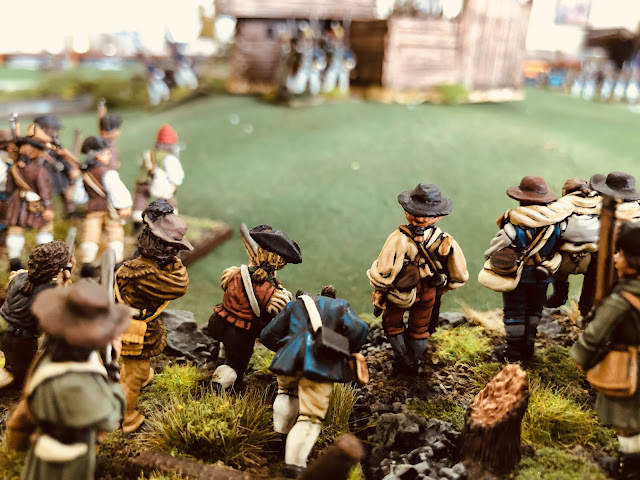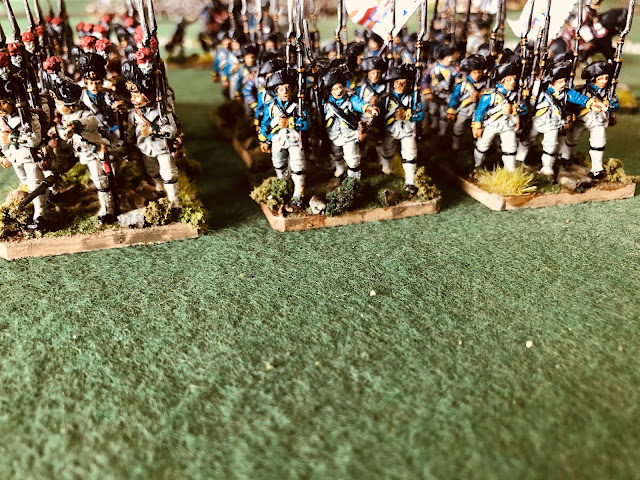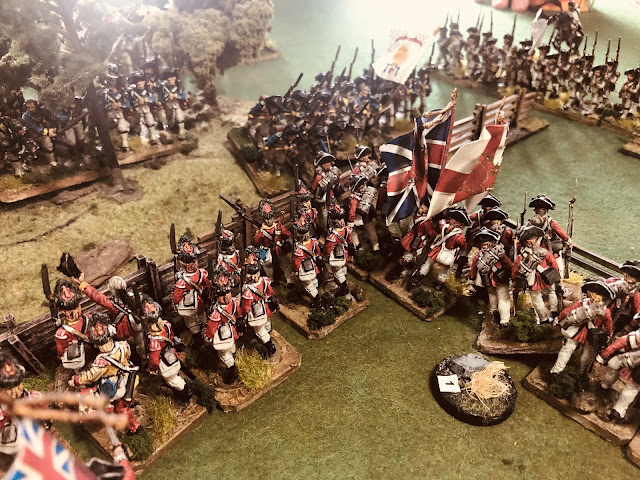Yesterday we played an American War of Independence game.
Often in our games we have reinforcements arriving during the game, but usually they are at the discretion of the umpire. I wanted to do something a little different. I wanted to start the game with a small force on each side and allow it to be reinforced, but calling reinforcements had to have a consequence. So this game is to be the first of two and decisions made in this one will have an impact in the next.
The basis of the game is that a Hessian force is holding a position at X (below) being attacked by an American force. The Hessians are not strong enough to hold the position without reinforcement. They can draw on reinforcements from their home bases at A and B (two brigades at A and three at B), but if they lose this fight they will need to fall back on their home base and if they strip too many reinforcements they may find themselves disadvantaged in the second fight. The British have an additional source support. There are allied Indians in the area, but no one, even the British, know where they are. Whenever an American unit enters an area of woods 1xD6 is rolled and of a 5 of 6 is rolled mean that they have encountered Indians, and a second roll of 5 or 6 means that they have been ambushed.
Similarly the attacking an Americans are not strong enough to drive the Hessians without reinforcements which they can draw on from C and D and they too have to be mindful of the second fight. The American force is stronger that the British, but the Americans have a number of raw militia which come with their own complication. The battlefield, X, and the American bases of C and D are in New Jersey while the British bases, A and B, are in New York and the militia cannot serve outside New Jersey, so would not be available in the in a battle at A or B, and the Americans need to decide how to best use them.
Two other things players need to consider. First is that losses are carried forward, so any reckless attacks will have a consequence. Second, lines of retreat need to be considered too because should only one be available to the defeated army, the consequence of crowded roads could lead to the disintegration of retreating units.
The map below shows the initial deployment and potential arrival points for reinforcements.
So what happened in the game? Well wargamers being wargamers, all three American players brought their entire force onto the table, completely stripping their home bases of troops. The British chose to bring their entire force at A, a total of six battalions and two guns, while the commander of force at B was hedging his bets, waiting to see if an opportunity arose, but protecting the home base.
Of the Hessians, the combined grenadiers and a tiny unit of Jägers occupied the fort while three line battalions, plus another tiny jäger units and a gun, deployed around the tavern.
The American force that was deployed on the table at the start game moved to cross the river, while the French force, with two battalions of militia attached, arrived in the deployment zone to the right of the river, facing the fort. The third force was delayed in arriving, but took the furthest right deployment area.
The Americans soon encountered Indians in the woods near the river, starting a fight that ran for most of the game.
The British reinforcements, two full brigades, including a combined grenadier battalion, and a field gun, took position behind the fences around the tavern.
The French commander left the militia to mask the fort.
With the fort neutralised, two brigades of French infantry swung right to engage the troops near the tavern.
Having extended beyond the British left, the French moved to the attack.
One British battalion was routed and the French battalion pushed on and drove off one of the Hessian battalions. The British combined grenadier battalion suddenly found itself in a difficult position and withdrew, but it was still a perilous situation.
With the Americans closing in a three sides the British decided to withdraw from the fight.
The Americans saw an opportunity and attempted to interrupt the British withdrawal.
The grenadiers attempted to withdraw but were attacked and routed. The rest of the British, with the exception of the Hessian grenadiers who were trapped in the fort, managed to put enough distance between then and the Americans to escape pursuit.
The American gamble had paid off. They managed to drive off the British for a small loss. The British were fortunate too. While they had lost the Hessian grenadiers and a unit of jagers and three other units were roughly handled, the bulk of their force was intact and the withdrawal was orderly and not pursued, so they suffered no additional loss in the retreat.
So for the next game. Thanks to their light losses and the decision of their third force to remain at their base the British are in a good position. The Americans are also in good condition, with only slight losses, but the six battalions of milita will not be available.




































